Josep Puig i Cadafalch
show This article may be expanded with text translated from the corresponding article in Catalan. (November 2010) Click [show] for important translation instructions. |

Josep Puig i Cadafalch (Catalan: [ʒuˈzɛp ˈputʃ]; Mataró, 17 October 1867 – Barcelona, 21 December 1956) was a Catalan Spanish Modernista architect who designed many significant buildings in Barcelona, and a politician who had a significant role in the development of Catalan institutions. He was the architect of the Casa Martí (also known as "Els Quatre Gats"), which became a place of ideas, projects and social gatherings for such well-known Catalans as Santiago Rusiñol and Ramon Casas.
Although Puig's style separated him significantly from his contemporary Gaudí, their relations were neither tense nor problematic, as demonstrated by the participation of both architects in the construction of the . Another of his significant buildings was the Casa Terrades (also known as "les Punxes"), which is known for its medieval castle style from the north of Europe.
Puig was actively involved in politics. He was a Barcelona City Councillor from 1901 to 1903, served in the Spanish Parliament from 1907 to 1910 and was the second president of the Commonwealth of Catalonia from 1917 to 1924. From 1942 to his death in 1956, he was the president of the academic institution of the Catalan language, the Institut d'Estudis Catalans.
He was also a great defender of Catalan culture and history which he hoped to see fully restored. He published studies of language, legal order and political organisation in the 11th-12th centuries. Amongst his important legacies is also the documentation and photographing of the culturally important buildings and art works the Vall d'Aran and Alta Ribagorça (including the Catalan Romanesque Churches of the Vall de Boí) during an expedition sponsored by the Institute for Catalan Studies in 1907.
Main works[]
Andorra[]
| Year | Name | Location | Description | Condition | Image |
|---|---|---|---|---|---|
| 1940 | Andorra la Vella 42°30′26″N 01°31′18″E / 42.50722°N 1.52167°E |
Reconstruction of the upper floor of the tower and the old side door of the Romanesque church. | Good | 
|
Argentona[]
| Year | Name | Location | Description | Condition | Image |
|---|---|---|---|---|---|
| 1897–1905 | Plaça de Vendre s/n 41°33′17.17″N 2°24′01.17″E / 41.5547694°N 2.4003250°E |
Summer house of the architect made from the transformation from three buildings. With a labyrinthine interior and a style of medieval influence, and has a façade with modernisme architectural elements. | Regular | 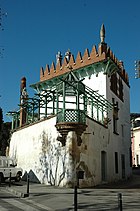
| |
| 1897 | Chapel del Sagrament | Plaça de l'Església 41°33′15″N 2°24′3″E / 41.55417°N 2.40083°E |
Expansion of the chapel del Sagrament of the Church of Sant Julià d'Argentona. The exterior of the chapel is decorated with gargoyles and an eaves tile modernists. | Very good | 
|
| 1898 | Can Calopa | C. Riudemeia, 8 41°33′12.65″N 2°24′2.36″E / 41.5535139°N 2.4006556°E |
Reforms in an existing house. The wrought iron fence and brick, the façade made of brick and a room decorated with modernisme elements mediated by Puig i Cadafalch. | Good | 
|
| 1898 | Camí de Sant Miquel del Cros, 9 41°32′9.35″N 2°24′46.50″E / 41.5359306°N 2.4129167°E |
Manor house converted by Puig i Cadafalch to a noble palace, presenting all of the advanced aesthetic currents of the moment. | Very good | 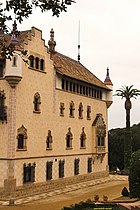
|
Barcelona[]
| Year | Name | Location | Description | Condition | Image | |
|---|---|---|---|---|---|---|
| 1893 | Joieria Macià | Carrer de Ferran, 18 | Puig made the decoration of jewelry. Had a neoclassical decoration with Neomedieval sculptural details and brackets are Neoclassical.[1] | Disappeared | ||
| 1896 | Casa Martí | C. Montsió, 3 bis 41°33′12.65″N 2°24′2.36″E / 41.5535139°N 2.4006556°E |
The ground floor is the place Els Quatre Gats, meeting venue of the modernise artists. | Very good | 
| |
| 1898 | Casa [2] | C. Boqueria, 12 41°22′53.46″N 2°10′27.48″E / 41.3815167°N 2.1743000°E |
Commissioned by the owner of the Casa Martí changed many times and use long housed the inn "Branch of the universe". Have a sgraffito façade topped with battlements. The forging is of and the cover is flanked by two statues of . Now houses a hotel. | Very good | ||
| 1898–1900 | Casa Amatller | Passeig de Gràcia, 41 41°23′29.5″N 2°9′54″E / 41.391528°N 2.16500°E |
The chocolate industrial , became a building of 1875, he bought to move it, and commissioned works at Puig i Cadafalch, which opted to give the appearance urban gothic palace. Among the artists who were collaborating include and responsibles of the sculpture, very important in the building. | Very good | 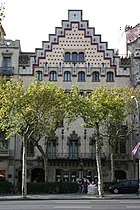
| |
| 1900 | House-study of the [3] | la Rambla, 18 41°22′40.6″N 2°10′34.3″E / 41.377944°N 2.176194°E |
Terraced building, of ground floor, main and three floors above designed by , which preserves the façade of the three upper floors. In 1900 the commission reforms to locate their study. | Totally transformed to locate in 1941. | 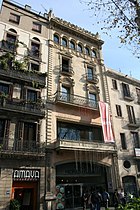
| |
| 1901 | Passeig de Sant Joan, 108 41°23′59.37″N 2°10′09.96″E / 41.3998250°N 2.1694333°E |
Urban residence with white and graffiti façade with windows decorated with sculptures and capitals by Eusebi Arnau with themes very contemporary. | Very good | 
| ||
| 1901 | Casa Muntadas | Av. Tibidabo, 48 41°24′55.46″N 2°7′59.23″E / 41.4154056°N 2.1331194°E |
Recreate the façade of a typical Catalan masia, decorated with floral framing doors and windows. | Very good | 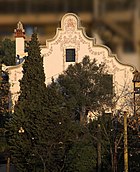
| |
| 1902 | Cafè Torino [4] | Passeig de Gràcia, 18 | Owned by the Turinan Flaminio Mezzalama, who sought to promote the Martini & Rossi vermouth, was inaugurated on September 20 of 1902[5] and that same year won an award from the City Council of Barcelona. The artists had decorated fashion as and Antoni Gaudí that made the Arab room. The furniture was Thonet, the decorative sculpture was by Massana i Buzzi, the fresco was by Saumell i Garcia and the locksmith by Ballarin. It closed around 1910-1911.[6] | Disappeared | 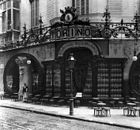
| |
| 1902 | Hotel Terminus | Carrer Aragó, 282 | Hotel located in the train station of Aragó-Passeig de Gràcia. It was a building of the rose time, very floral on the outside with a wavy capcir own of the Baroque masias. | Disappeared in the 1960s. | 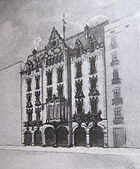
| |
| 1903 | Casa Serra | Rambla de Catalunya, 126 41°23′41.16″N 2°09′25.86″E / 41.3947667°N 2.1571833°E |
The façade was built in stone and beautifully decorated, matched to the Plateresque style, and is work by . | Very good | 
| |
| 1903 | Casa Mercè Pastor de Cruïlles | Ctra. Vallvidrera a Tibidabo 102-104 41°25′26.6″N 2°07′8.56″E / 41.424056°N 2.1190444°E |
The Torre Pastor, single-family and study, commissioned by Mercedes Pastor, is composed in the manner of the Catalan manor houses of the 15th century, from a solid body, covered hipped, with eaves and a large angular tower. Highlights the placement of blocks in opus spicatum. He is currently a religious residence of Salesian community. | Regular | 
| |
| 1904 | Casa Eustaqui Polo[7] | , 55-57 (originally was num. 149)[8] | t was commissioned by Eustaqui Polo i Ortigosa, father of the writer . It was a modernist building with extensive gardens that was sold in 1956 to then be demolished to build three blocks of flats. | Demolished in 1956 | 
| |
| 1904 | Casa Trinxet | Carrer Còrsega, 268 | It was commissioned by (in Catalan, Avel·lí Trinxet i Casas), a textile industrial uncle of the artist who decorated the rooms with mural paintings. With a clear influence of Secession, was part of the white time of Puig and was considered the work which began the transition to . Despite heavy opposition to its demolition, the Barcelona council allowed the disappearance of Casa Trinxet at the hands of real estate Nuñez i Navarro in March 1967. | Demolished in 1967 | 
| |
| 1904 | Pantheon Terrades[7] | No documentation. | ? | |||
| 1904–1906 | , 373 41°23′47.92″N 2°9′41.09″E / 41.3966444°N 2.1614139°E |
The commissioned Puig i Cadafalch in 1900 to build their new house in Barcelona after finishing his palace in Massanes. The building is now the seat of . | Very good | 
| ||
| 1905 | Casa Terrades Casa de les Punxes |
Av. Diagonal, 416-420 41°23′52.5″N 2°9′49.26″E / 41.397917°N 2.1636833°E |
Apartment building structured on three scales commissioned by Àngela Brutau, widow of Terrades -client's farm Seva and pantheon of Terrades-, to reach her three daughters and that allows them to live of rent. It is a building of "medieval" look which, it says, Puig could have been inspired by the building that appears at the bottom of the painted gothic table called Virgin of the Consellers.[9] | Very good | 
| |
| 1905 | Farmàcia Sastre i Marquès | C. Hospital, 109 | The property was demolished to open the Rambla del Raval. Some decorative elements such as a lamp, mosaics and some stained glass were recovered before its demolition.[1] | Demolished | ||
| 1905 | Casa Sastre i Marqués | C. Cardenal Vives i Tutó, 29-35 41°23′40.39″N 2°7′16.9″E / 41.3945528°N 2.121361°E |
Private house framed in white period. The architect combined brick with sgraffito and tile glaze. A roundabout at the corner of the garden. | Recently restored. | 
|
|
| 1905 | Building commissioned by Sastre i Marqués for his family | Calle Princesa 20 | Good | |||
| 1909 | Casa Llorach | C. Muntaner, 265 | Commissioned by Concepció Dolsa, widow of Llorach. It had a large garden overlooking the street of Muntaner with a fence building of smooth undulations. The building, of Alpine inspiration, had some amazing graffiti on the main façade.[1] | Disappeared | 
| |
| 1910 | Casa Àngels Macià i Monserdà[10] | C. Anglí | ? | |||
| 1911 | C. Buenos Aires, 56-58 41°23′35.29″N 2°8′54.0″E / 41.3931361°N 2.148333°E |
Corresponds to the white time and has a Nordic touch. Now host the Museum of Sports of Catalonia. | Very good | 
| ||
| 1911 | Avinguda de Francesc Ferrer i Guàrdia, 6-8 41°22′16.79″N 2°8′59.1″E / 41.3713306°N 2.149750°E |
The Casaramona Factory is a project by architect Puig i Cadafalch commissioned by Casimir Casaramona i Puigcercós, owner of textile business, to build a new factory at the foot of Montjuïc, to replace one earlier destroyed by a fire. Currently houses the CaixaForum. | Very good | 
| ||
| 1913 | Casa Joaquim Carreras "Santa Margarita" [11] | C. Sant Pere Claver | Neoclassical building, very geometric, with large gardens and walkways with pergolas to save the unevenness of the terrain through stairways and balconies with balusteres.[1] | Disappeared | 
| |
| 1914 | Casa Miele | C. Ferran 2 and la Rambla 41°22′49.2″N 2°10′27.36″E / 41.380333°N 2.1742667°E |
The Casa Miele, that sold domestic objects made of metal called precisely "Miele silver", a German invention of great international success and not just imitate the qualities of real silver but improved. Due to installing this luxurious and popular store, the architect Puig i Cadafalch did a total reform of the house which won an honorable mention in the . Currently the building has been transformed, but it shows his hand on some items that have survived: fragments of the railings on the ground floor, decoration of the balconies and rearrangement of the windows.[12] | Transformed | 
| |
| 1914 | Palau de la Generalitat de Catalunya | Pl. Sant Jaume, 4 41°22′58″N 2°10′36″E / 41.38278°N 2.17667°E |
The establishment of the Commonwealth of Catalonia resulted in the recovery of the Palau de la Generalitat as a symbol of Catalanism. Enric Prat de la Riba commissioned to Puig i Cadafalch the rehabilitation and removal of Spanish or monarchic signs. The work allowed to place the National Library of Catalonia within the palace. | Good | 
| |
| 1914 | Pg. Bonanova, 55 41°24′12.67″N 2°7′44.5″E / 41.4035194°N 2.129028°E |
Built by order of , Sultan Moroccan exile in Barcelona, is a building with a certain eastern touch. It currently houses the Consulate of Mexico. | Very good | 
| ||
| 1917 | Casa Puig i Cadafalch | C. de Provença, 231 41°23′35.55″N 2°9′33.5″E / 41.3932083°N 2.159306°E |
It was his private house and where he died in 1956. It is a sober building, of his yellow time, in which Puig gives for completion the Gothic palace and center-European villa, seeking a more urban and repeatable housing of households.[13] | Very good | 
| |
| 1918 | Restaurant of the Font del Gat | 41°22′4.17″N 2°9′27.6″E / 41.3678250°N 2.157667°E |
He rebuilt the development work in the area of the font del Gat (fountain of the cat) designed by Jean-Claude Nicolas Forestier in the development plan of the Montjuic mountain and joined the restaurant. For years has not the role of restaurant, and currently hosts the headquarters of the Royal Spanish Federation of Tennis.[14] | Good | 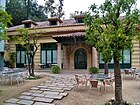
| |
| 1920 | Casa Carreras | C. Montsió, 5 41°23′08.80″N 2°10′25.6″E / 41.3857778°N 2.173778°E |
It can not be stressed that this is only the reform of an existing building. The façade of the passage there are two panels of painted tiles. One with St. Joachim on the portal of No. 4 and, on the edge of Montsió, another with St. Eloi of excellent modernisme drawing under stone niche very ornate. | Very good | 
| |
| 1919 | The Four Columns | Pl. Cascades, s/n | The Ionic four columns were a monument to the Catalanism, that represented the four vertical red bars of the Catalan flag and was also tied to the idea of progress represented by the 1929 Barcelona International Exposition. They were demolished by the dictatorship of Primo de Rivera which sought to remove any symbol of Catalan identity in the eyes of the world. However, thanks to the popular initiative in December 2010 were returned to raise a one less meter of tall at the same place where they were stationed in the beginning. Currently these are a symbol of perseverance, conviction and strength of language, culture and Catalan national identity. | Very good. Demolished in 1928. Lifted in December 2010 | 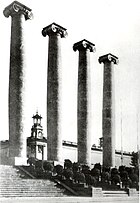
| |
| 1920 | Palaus d'Alfons XIII i de Victòria Eugènia Fira de Barcelona |
Pl. Cascades, s/n 41°22′13.70″N 2°9′7.8″E / 41.3704722°N 2.152167°E |
These are the only two palaces by Puig of the built complex for the 1929 Barcelona International Exposition. Between them, to the front of the avenue and shaping the square, were was the . | Good | 
| |
| 1921 | Plaça de Catalunya, 9 41°23′15.19″N 2°10′07.16″E / 41.3875528°N 2.1686556°E |
It is a reform of an original building of Josep Vilaseca i Casanovas dedicated to offices, except the top floor which was home of the owner. | Good | 
| ||
| 1922 | Casa Luis Guarro | Via Laietana, 37 41°23′9.23″N 2°10′33.84″E / 41.3858972°N 2.1760667°E |
Office building and terraced homes of Noucentisme style that, besides the traditional elements of the neoclassical style, also has some neo-Baroque elements such as the thick columns or garlands of flowers and fruits of the frontispiece. Is part of the yellow time. It was commissioned by the paper industrialist Lluís Guarro.[15] | Regular | 
| |
| 1924 | Casa Casaramona | Passeig de Gracia, 48-52 41°23′30.82″N 2°9′56.64″E / 41.3918944°N 2.1657333°E |
House built by order of Casimir Casarramona, who had already commissioned his factory (Fàbrica Casaramona), years before. It is a restoration of an existing building that already incorporates a little of modernisme style, similar to the Casa Guarro in Via Laietana and clearly located to his yellow period. | Good | 
| |
| 1924 | 17th-century building | Carrer Sant Pere Més Alt, 24 (Ciutat Vella) |
He renovated an existing 17th century building. Reform the ground and three floors as well as the penthouse. | Very good | 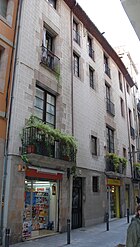
| |
| 1928 | Casa Rosa Alemany | Av. República Argentina, 6 41°24′26.38″N 2°8′54.84″E / 41.4073278°N 2.1485667°E |
Also attributed to Lluís Planas, is an apartment building, of ground and six floors of Noucentisme style. The composition of the façade plays around the location of windows and balconies that are different in each floor. On the door is a statue of Diana. It was considered a sign of the highest modernity of the time and had the main floor located on the top floor, unlike the location in the main. It was commissioned by the political . | Good | 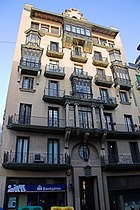
|
Canet de Mar[]
| Year | Name | Location | Description | Condition | Image |
|---|---|---|---|---|---|
| 1898 | Restaurant of the Hermitage of la Misericòrdia | Parc de la Misericòrdia 41°35′49.6″N 2°34′55.15″E / 41.597111°N 2.5819861°E |
Storey building with typical structure of Puig i Cadafalch with neo-Gothic windows similar to Els Quatre Gats and a lookout tower typical in the modernisme towers. The decor of shades in blue tiles. | Good | 
|
| 1899 | Fàbrica Carbonell Susagna | Riera Lledoners, 111 41°35′33.56″N 2°34′57″E / 41.5926556°N 2.58250°E |
The knitting factory was originally in 1899. Joan Carbonell Reverter, son of Joan Carbonell continued the business and changed the name to Carbonell Reverter. It was designed in 1897-98 and began production called Carbonell Susagna and was promoted by industrials Frederic Susagna and Joan Carbonell Paloma. The master builders were Martí Isern and Joan Solà. Remains just the form of entry, of brick.[16] | Degraded |
Esplugues de Llobregat[]
| Year | Name | Location | Description | Condition | Image |
|---|---|---|---|---|---|
| 1904 | Pantheon Garí | Parish Cemetery 41°22′45.26″N 2°05′01.24″E / 41.3792389°N 2.0836778°E |
Cadafalch build it for the family Garí (those of of Argentona) in the area of pantheons of the parish cemetery of Esplugues de Llobregat. It consists of a pedestal with a cylindrical column which there is a wrought iron cross with Christ at the foot of the column that has representations of animals such as snake or toad. | Regular | 
|
la Garriga[]
| Year | Name | Location | Description | Condition | Image |
|---|---|---|---|---|---|
| 1902 | Casa Furriols[17] | C. Carrerada, 1 41°40′52.9″N 2°17′22.96″E / 41.681361°N 2.2897111°E |
House of two floors and lofts with two covered waters. In very simple structure, highlights the delicate sgraffitos of the main façade. The fence on the street is decorated with the same tiles that would use in the Casa Carreras. | Good | 
|
Lloret de Mar[]
| Year | Name | Location | Description | Condition | Image |
|---|---|---|---|---|---|
| 1898 | Creu de Terme, oratori i reformes[18] | Sant Pere del Bosc 41°42′42.55″N 2°47′26.69″E / 41.7118194°N 2.7907472°E |
The colonial Nicolau Font i Maig, count of Jaruco, commissioned to Puig the direction of the reform of the shrine of , who participated with paintings of the church, and with the sculptures. Puig designed the access roads, an oratory in the Mare de Deu de Gràcia and a creu de terme, with a Saint George work by Arnau, opened the May 1 of 1898 and that Monsignor Jacint Verdaguer devotes some verses to his song "La Creu". | Good |   
|
| 1902 | Pantheon Costa i Macià | 41°42′06.80″N 2°50′09.9″E / 41.7018889°N 2.836083°E |
Pantheon covered to two sides, open on three sides with holes with arch and pillars finished with capitals, closed with a very elaborate wrought iron work of Eduard Ballarin. The sculptures are of and mosaics of . | Good | 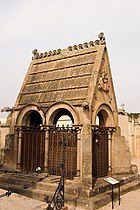
|
Massanes[]
| Year | Name | Location | Description | Condition | Image |
|---|---|---|---|---|---|
| 1900 | Palau del Baró de Quadras | Mas Quadres 41°45′22.46″N 2°39′32.19″E / 41.7562389°N 2.6589417°E |
Big house, built in neo-Gothic style built for the industrialist Manuel Quadres i Feliu, first . Square design with three floors and two towers with battlements on each side. It has a large doorway with the coat of the family. | Good | 
|
Mataró[]
| Year | Name | Location | Description | Condition | Image |
|---|---|---|---|---|---|
| 1891 | Casa Sisternes | C. Sant Simó, 18 41°32′26.19″N 2°26′52.61″E / 41.5406083°N 2.4479472°E |
It is considered the first work of the architect. Highlights of the decorative lines of the façade of wrought iron combined with brick and tile, which define his style. | Bad | 
|
| 1893 | Edifici del Rengle | Pl. Gran s/n 41°32′24.7″N 2°26′48.61″E / 41.540194°N 2.4468361°E | Building for the market stalls built by Emili Cabañes in 1891. Two years later, Puig i Cadafalch reformed it adding wrought ceramics to the roof and iron ornamental. | Good | 
|
| 1893 | Reform to the Chamber of the City Council | La Riera, 48 41°32′23.24″N 2°26′41.21″E / 41.5397889°N 2.4447806°E | Highlights the coffered ceiling of the Chamber, decorated with Catalan national symbols, coats and borders. | Good | 
|
| 1894 | Store "la Confianza" | C. Sant Cristòfor, 10 41°32′22.75″N 2°26′48.74″E / 41.5396528°N 2.4468722°E | Responsible for the interior decoration and furniture. Neo-Gothic elements and floral decoration. Opened in 1896. | Very good | 
|
| 1894 | Casa Parera | C. Nou, 20 41°32′27.25″N 2°26′41.39″E / 41.5409028°N 2.4448306°E | Remodelation of an old house with a neo-gothic elements, stucco and forge. engraved s flowers and vegetables. The sculptures on the façade are attributed to . | Good | 
|
| 1894 | La Beneficiencia | C. Sant Josep, 9 41°32′22.07″N 2°26′36.38″E / 41.5394639°N 2.4434389°E | Charity house to house orphans and disadvantaged women's. Sober decoration with some coat of arms and statues by in the capitals. | Good | 
|
| 1897 | Casa Coll i Regàs | C. Argentona, 55 41°32′26.68″N 2°26′58.59″E / 41.5407444°N 2.4496083°E | Private house commissioned by Joaquim Coll i Regàs combining the sculpture of with sgraffitos, tiles, leaded windows. | Very good | 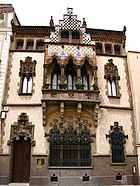
|
Monistrol de Montserrat[]
| Year | Name | Location | Description | Condition | Image |
|---|---|---|---|---|---|
| 1896 | Fifth Mystery of Pain of the . | Way of the | It is the sculptural group of the Crucifixion of Jesus that was executed by sculptor Josep Llimona. | Good | |
| 1901 | Third Mystery of Joyful of the . | Way of the | It is the sculptural group of the Birth of Jesus that was executed by sculptor Josep Llimona. | Good | |
| 1925–1928 | Santa Maria de Montserrat | 41°35′35.54″N 1°50′13.7″E / 41.5932056°N 1.837139°E | Construction of the neo-Romanesque cloister and the Plaça de Santa Maria; reform of the refectory of 17th century, the choir and the nursing; expansion of the library. | Good | 
|
el Prat de Llobregat[]
| Year | Name | Location | Description | Condition | Image |
|---|---|---|---|---|---|
| 1911 | La Telegrafia | finca La Ricarda | Building commissioned for houses the English company Marconi Wireless Telegraph dedicated to the exploitation of telegraph. Puig commissioned the work to local builder Josep Monés i Jané. It has two floors and is built on a medical floor built with piles of concrete and vaults. Today has been declared a cultural site of local interest since 1996.[19] | Good |
Sant Fruitós de Bages[]
| Year | Name | Location | Description | Condition | Image |
|---|---|---|---|---|---|
| 1907 | Monestir de Sant Benet de Bages |
41°44′33.81″N 1°53′56.7″E / 41.7427250°N 1.899083°E | Restoration of the monastery commissioned by Ramon Casas, owner and friend of the architect. | Very good | 
|
Sant Quirze Safaja[]
| Year | Name | Location | Description | Condition | Image |
|---|---|---|---|---|---|
| 1919 | [20] | "El Maset" 41°42′57.47″N 2°8′56″E / 41.7159639°N 2.14889°E |
It was commissioned by Merce Fargas Raymat, mother of and owner of the "Finca El Maset" name which the house is also called. The property was sold by heirs of original owner to the current owners. It is a square building with a tower, pointed to the extreme northwest. It has three floors and roof water to two with a large gallery on the south façade. The structure resembles the "Granja Terrades" of Seva. | Very good | 
|
Sant Sadurní d'Anoia[]
| Year | Name | Location | Description | Condition | Image |
|---|---|---|---|---|---|
| 1895–1920 | Caves Codorniu | Can Codorniu | Work of industrial architecture driven by for his family's Codorníu Winery. Consisting of several buildings and areas where Puig i Cadafalch found innovative solutions to each according to its functionality. | Very good | 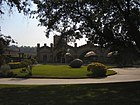
|
| 1904 | Tower Codorniu | Can Codorniu | The main building or "big house" of the institution, is a square building with three towers, so that its profile is matched to that of the Casa de les Punxes. | Very good |
Seva[]
| Year | Name | Location | Description | Condition | Image |
|---|---|---|---|---|---|
| 1904 | Granja Terrades | Ctra. de Seva a Viladrau 41°50′41.77″N 2°19′19.11″E / 41.8449361°N 2.3219750°E | Modernisme house built next to Mas Sobrevia (12th century), name that is now known due have abandoned the functions of farm. | Very good | 
|
Tàrrega[]
| Year | Name | Location | Description | Condition | Image |
|---|---|---|---|---|---|
| 1898 | Cal Maimó [21] | Carrer Alonso Martínez, 37 41°38′59.9″N 1°08′19.57″E / 41.649972°N 1.1387694°E | It has a pinnacle finished with some neo-Gothic ornamentation in the façade. It currently houses the charismatic establishment "Cafè Estació". | Very good | 
|
Viladrau[]
| Year | Name | Location | Description | Condition | Image |
|---|---|---|---|---|---|
| 1898 | Casa Eusebi Bofill | ? | Puig built a detached house on use the chimney and the fireplace to articulate the space to Frank Lloyd Wright style, although it looked like based on Catalan masía had a highly ornamental neo-Gothic design.[22] | ? | |
| 1901 | Villa Gloria - Can Capella | Viladrau - centre | Commissioned by the newspaper and publishing family of the Godo brothers as a holiday house. Originally called Villa Gloria and later changed to Can Capella. A modernista house with a 'Swiss chalet' styling, it was used as a regional command centre in the Civil war. The few changes since its construction include additional chimneys and slate tiles replacing the original yellow ceramic 'fish-scale' tiles on the curved rear terrace roof. | Restored 2005 using original materials | |
| 1900 | Can Torra or Xalet Espriu | The house built in a Modernisme-neo-Gothic style was acquired in 1923 by the father Salvador Espriu and he spend long periods when a child was delicate of health. Later was transformed and highly denatured.[23] Currently is known as Can Torra, named by the owners since the 1950s.[24] | Very transformed |  Original construction | |
| 1903 | Casa Riera i Puig | Passeig de la Sanitat, 1 | Family housing. | ? |
Viladecans[]
| Year | Name | Location | Description | Condition | Image |
|---|---|---|---|---|---|
| 1917 | Casa Pilar Moragues | Camping el Toro Bravo | Summer house commissioned by the Moragues family. It is a house inspired in the rational style of Puig, who built it on his second period, "the white time". It has a rectangular gabled roof, which was built to protect it from high groundwater, has ground floor, first floor, attic and cellar semiburied. Until recently had roles as holiday camp within the perimeter of the camping "El Toro Bravo". With the recent expansion of the Barcelona Airport, the building has been given to the City Council of Viladecans that it restored for a museum of the coastline park.[25] | Very good |
References[]
- ^ Jump up to: a b c d Cabré 2001, p. 157.
- ^ Permanyer, Lluís (25 November 2010). "Un 'nuevo' Puig i Cadafalch". La Vanguardia (in Spanish). p. 5.
- ^ García Felguera, María de los Santos (2005–2006). "Anaïs Tiffon, Antonio Fernández y la compañía fotográfica "Napoleon"" (PDF). Locvs Amœnvs (in Spanish) (8): 307–335. Archived from the original (PDF) on 18 July 2011.
- ^ "Josep Puig i Cadafalch (España, 1867-1956)" (in Spanish). 1998–2021.
- ^ "Barcelona, memoria de un siglo - La década de la Reforma - Cronología". Barcelona Metròpolis mediterrània nº45 (in Spanish).
- ^ "Sortim". Ruta del Modernisme (in Catalan). Ajuntament de Barcelona | Institut Del Paisatge Urbà i La Qualitat De Vida. Archived from the original on 3 March 2012.
- ^ Jump up to: a b Cabré 2001, p. 151–156.
- ^ Polo 2005, p. 36.
- ^ Cabré 2001, p. 53.
- ^ Fundació Caixa de Pensions 1989, p. 191.
- ^ "Obra Privada De Sarrià i Vallvidrera, 1845-1922" (PDF). Arxiu municipal de Sarrià-Sant Gervasi (in Catalan). Archived from the original (PDF) on 21 November 2004.
- ^ Bohigas, Oriol (3 May 2006). "L'Ajuntament de BCN s'ha oblidat de controlar la qualitat arquitectònica i estètica dels comerços - Botigues pernicioses". Barcelona al dia (in Catalan).
- ^ Cabré 2001, p. 36.
- ^ "Notícies". La web de la ciutat de Barcelona (in Catalan). Archived from the original on 26 July 2012.
- ^ Cabré 2001, p. 64.
- ^ "Fàbrica Carbonell Reverter (Canet de Mar - Maresme)". Pobles de Catalunya (in Catalan).
- ^ Cuspinera i Font 1978.
- ^ "Municipis Lloret de Mar>>Guia" (in Catalan). Archived from the original on 5 October 2011.
- ^ "Ruta desconocida. Casa La Telegrafía (Puig i Cadafalch de la mano con...Marconi)". Tot Barcelona (in Spanish). 18 February 2010.
- ^ Barral i Altet 2003, p. 97.
- ^ "Turisme a Tàrrega". L'Ajuntament de Tàrrega (in Catalan). Archived from the original on 29 August 2011.
- ^ MacKay 2003, p. 149.
- ^ Espriu & Comas 2007, p. 124.
- ^ Albesa i Riba 1996, p. 39.
- ^ "'Ca la Pilar', de Puig i Cadafalch, serà un equipament públic de Viladecans". E-Digital (in Catalan). 16 July 2010. Archived from the original on 28 September 2010.
Bibliography[]
- Albesa i Riba, Carles (1996). Postals del Montseny. Cavall Bernat, 29 (in Catalan). 2. Barcelona: L'Abadia de Montserrat. ISBN 84-7826-700-X.
- Banus Tort, Joan; Bosch de Doria, Marc; Sanroma, Pilar Vera (2001). Guia Puig i Cadafalch Mataró – Argentona (in Catalan, Spanish, and English). Mataró: Ajuntaments de Mataró i Argentona. ISBN 84-95127-64-4.
- Barral i Altet, Xavier, ed. (2003). "Josep Puig i Cadafalc: escrits d'arquitectura, art i política". Memòries de la Secció Històrico-Arqueològica (in Catalan). Barcelona: Institut d'Estudis Catalans (62). ISBN 84-7283-717-3.
- Cabré, Tate; Blanch, Montserrat (2001). Blanch, Montserrat (ed.). Guia de la ruta Puig i Cadafalch (in Catalan). photos by Lluís Casals. Barcelona: Mediterrània. ISBN 84-8334-264-2.
- Cabré, Tate (2001). Guia de la ruta Puig i Cadafalch (in Spanish). Barcelona: Institut Municipal Del Paisatge Urbà i La Qualitat De Vida/Mediterrània. ISBN 84-8334-272-3.
- Cuspinera i Font, Lluís (1978). La Garriga: guia arquitectònica (in Catalan). Barcelona: Caixa de Pensions per a la Vellesa i d'Estalvis de Catalunya i Balears. ISBN 84-500-2806-X.
- Espriu, Salvador; Comas, Antoni (2007). Comas Lamarca, Mercè (ed.). Del seu afm. Espriu: correspondència de Salvador Espriu amb Antoni Comas (in Catalan). Barcelona: Abadia de Montserrat. ISBN 978-84-8415-908-7.
- MacKay, David (2003). "L'arquitectura domèstica de Puig i Cadafalch: un eco del dilema actual (estil o no estil)". In Balcells, Albert (ed.). Puig i Cadafalch i la Catalunya contemporània. Jornades Cientifiques, 13 (in Catalan). Barcelona: Institut d'Estudis Catalans. pp. 147–152. ISBN 84-7283-702-5.
- Polo, Xavier (2005). Todos los catalanes son una mierda: les grans gestes contra el franquisme: la història d'una vida (PDF) (in Catalan). Introduction by Jordi Pujol. Barcelona: Proa. ISBN 84-8437-772-5. Archived from the original (PDF) on 12 January 2012.
- Fundació Caixa de Pensions, ed. (1989). Josep Puig i Cadafalch: arquitectura entre la casa i la ciutat [Josep Puig i Cadafalch: architecture between the house and the city] (in Catalan and English). Barcelona: La Fundació. ISBN 84-7664-239-3.
External links[]
| Wikimedia Commons has media related to Josep Puig i Cadafalch. |
- Barcelona Architecture at the Wayback Machine (archived 22 October 2009) Chronology of Catalan architecture and biographies of Catalan architects, from the gothic master builders to contemporary architecture, including Josep Puig i Cadafalch
- 1867 births
- 1956 deaths
- People from Mataró
- Architects from Catalonia
- 19th-century Spanish architects
- Modernisme architects
- Members of the Institute for Catalan Studies
- Corresponding Fellows of the Medieval Academy of America
- 20th-century Spanish architects
